Page 219 of 350
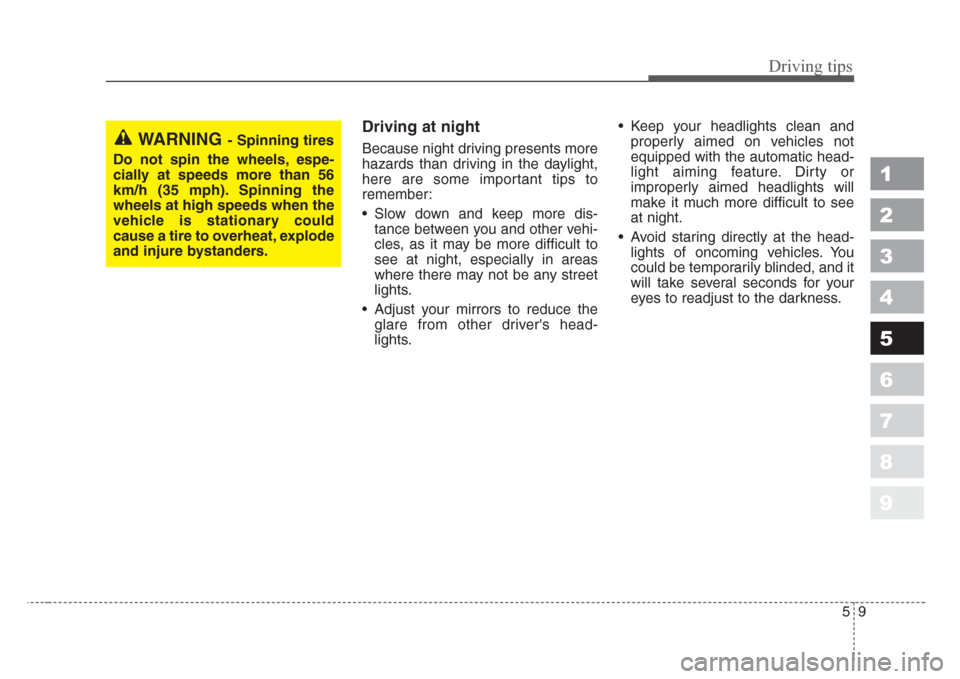
59
Driving tips
1
2
3
4
5
6
7
8
9
Driving at night
Because night driving presents more
hazards than driving in the daylight,
here are some important tips to
remember:
• Slow down and keep more dis-
tance between you and other vehi-
cles, as it may be more difficult to
see at night, especially in areas
where there may not be any street
lights.
• Adjust your mirrors to reduce the
glare from other driver's head-
lights.• Keep your headlights clean and
properly aimed on vehicles not
equipped with the automatic head-
light aiming feature. Dirty or
improperly aimed headlights will
make it much more difficult to see
at night.
• Avoid staring directly at the head-
lights of oncoming vehicles. You
could be temporarily blinded, and it
will take several seconds for your
eyes to readjust to the darkness.WARNING- Spinning tires
Do not spin the wheels,espe-
cially at speeds more than 56
km/h (35 mph).Spinning the
wheels at high speeds when the
vehicle is stationary could
cause a tire to overheat, explode
and injure bystanders.
Page 220 of 350
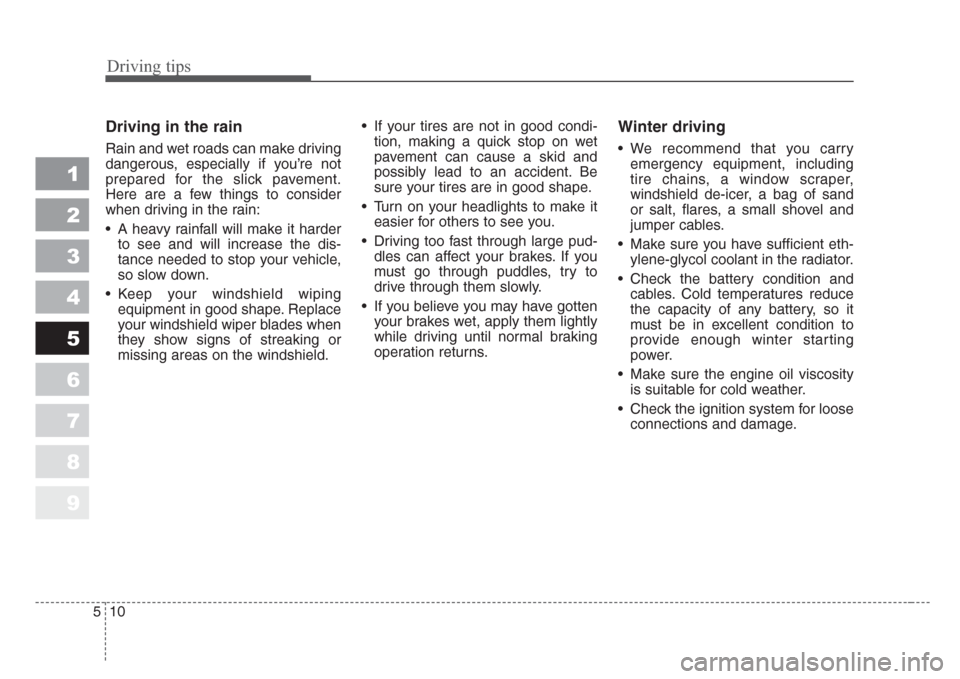
Driving tips
10 5
1
2
3
4
5
6
7
8
9
Driving in the rain
Rain and wet roads can make driving
dangerous, especially if you’re not
prepared for the slick pavement.
Here are a few things to consider
when driving in the rain:
• A heavy rainfall will make it harder
to see and will increase the dis-
tance needed to stop your vehicle,
so slow down.
• Keep your windshield wiping
equipment in good shape. Replace
your windshield wiper blades when
they show signs of streaking or
missing areas on the windshield.• If your tires are not in good condi-
tion, making a quick stop on wet
pavement can cause a skid and
possibly lead to an accident. Be
sure your tires are in good shape.
• Turn on your headlights to make it
easier for others to see you.
• Driving too fast through large pud-
dles can affect your brakes. If you
must go through puddles, try to
drive through them slowly.
• If you believe you may have gotten
your brakes wet, apply them lightly
while driving until normal braking
operation returns.
Winter driving
• We recommend that you carry
emergency equipment, including
tire chains, a window scraper,
windshield de-icer, a bag of sand
or salt, flares, a small shovel and
jumper cables.
• Make sure you have sufficient eth-
ylene-glycol coolant in the radiator.
• Check the battery condition and
cables. Cold temperatures reduce
the capacity of any battery, so it
must be in excellent condition to
provide enough winter starting
power.
• Make sure the engine oil viscosity
is suitable for cold weather.
• Check the ignition system for loose
connections and damage.
Page 232 of 350
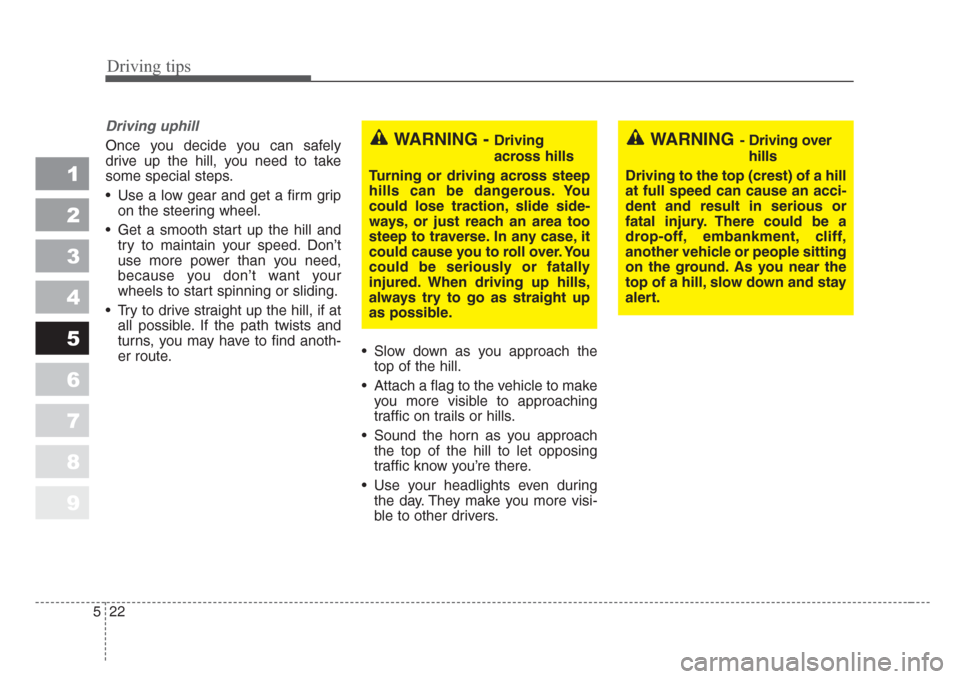
Driving tips
22 5
1
2
3
4
5
6
7
8
9
Driving uphill
Once you decide you can safely
drive up the hill, you need to take
some special steps.
• Use a low gear and get a firm grip
on the steering wheel.
• Get a smooth start up the hill and
try to maintain your speed. Don’t
use more power than you need,
because you don’t want your
wheels to start spinning or sliding.
• Try to drive straight up the hill, if at
all possible. If the path twists and
turns, you may have to find anoth-
er route.• Slow down as you approach the
top of the hill.
• Attach a flag to the vehicle to make
you more visible to approaching
traffic on trails or hills.
• Sound the horn as you approach
the top of the hill to let opposing
traffic know you’re there.
• Use your headlights even during
the day. They make you more visi-
ble to other drivers.WARNING - Driving
across hills
Turning or driving across steep
hills can be dangerous.Yo u
could lose traction,slide side-
ways, or just reach an area too
steep to traverse.In any case,it
could cause you to roll over.Yo u
could be seriously or fatally
injured.When driving up hills,
always try to go as straight up
as possible.WARNING- Driving over
hills
Driving to the top (crest) of a hill
at full speed can cause an acci-
dent and result in serious or
fatal injury.There could be a
drop-off, embankment, cliff,
another vehicle or people sitting
on the ground.As you near the
top of a hill,slow down and stay
alert.
Page 270 of 350
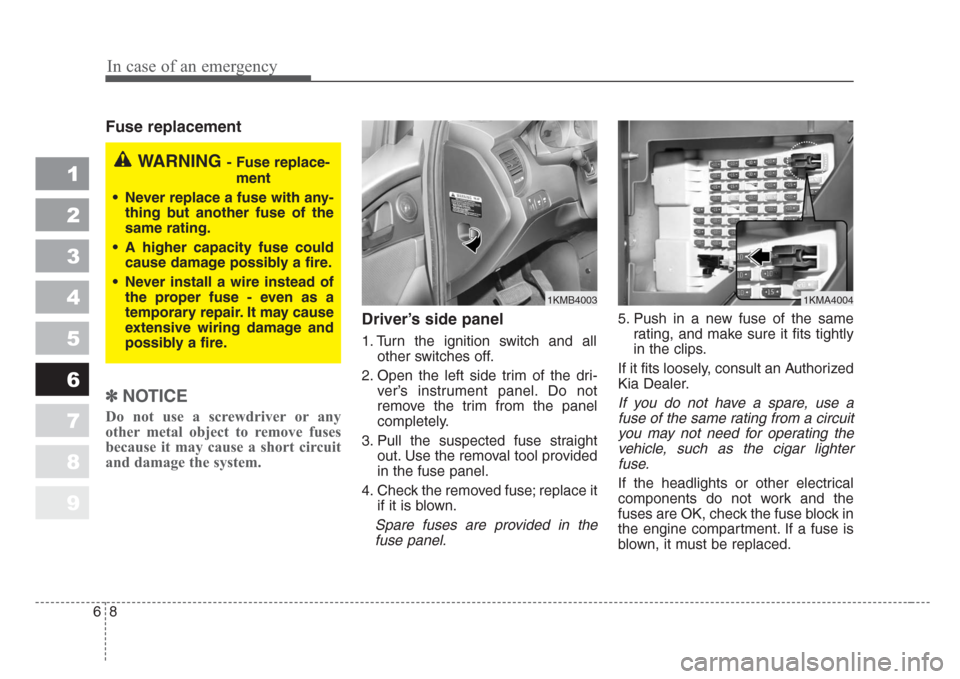
In case of an emergency
8 6
Fuse replacement
✽
NOTICE
Do not use a screwdriver or any
other metal object to remove fuses
because it may cause a short circuit
and damage the system.
Driver’s side panel
1. Turn the ignition switch and all
other switches off.
2. Open the left side trim of the dri-
ver’s instrument panel. Do not
remove the trim from the panel
completely.
3. Pull the suspected fuse straight
out. Use the removal tool provided
in the fuse panel.
4. Check the removed fuse; replace it
if it is blown.
Spare fuses are provided in the
fuse panel.
5. Push in a new fuse of the same
rating, and make sure it fits tightly
in the clips.
If it fits loosely, consult an Authorized
Kia Dealer.
If you do not have a spare, use a
fuse of the same rating from a circuit
you may not need for operating the
vehicle, such as the cigar lighter
fuse.
If the headlights or other electrical
components do not work and the
fuses are OK, check the fuse block in
the engine compartment. If a fuse is
blown, it must be replaced.
1
2
3
4
5
6
7
8
9
1KMB40031KMA4004
WARNING - Fuse replace-
ment
• Never replace a fuse with any-
thing but another fuse of the
same rating.
•A higher capacity fuse could
cause damage possibly a fire.
• Never install a wire instead of
the proper fuse - even as a
temporary repair.It may cause
extensive wiring damage and
possibly a fire.
Page 275 of 350
613
In case of an emergency
1
2
3
4
5
6
7
8
9
Power connector fuse
Your vehicle is equipped with a
power connector fuse to prevent bat-
tery discharge if your vehicle is
parked without being operated for
prolonged periods. Use the following
procedures before parking the vehi-
cle for prolonged period.
1. Turn off the engine.
2. Turn off the headlights and tail
lights.
3. Open the driver’s side panel cover
and pull up the “P/CONN 30A”.
✽
NOTICE
• If the power connector fuse is
pulled up from the fuse panel, the
warning chime, audio, clock and
interior lamps, etc., will not oper-
ate. Some items must be reset after
replacement. (Refer to “Items to
be reset···.” on page 7-32)
• Even though the power connector
fuse is pulled up, the battery can
still be discharged by operation of
the headlights or other electrical
devices.
1KMA4005
Power connector fuse
Page 319 of 350
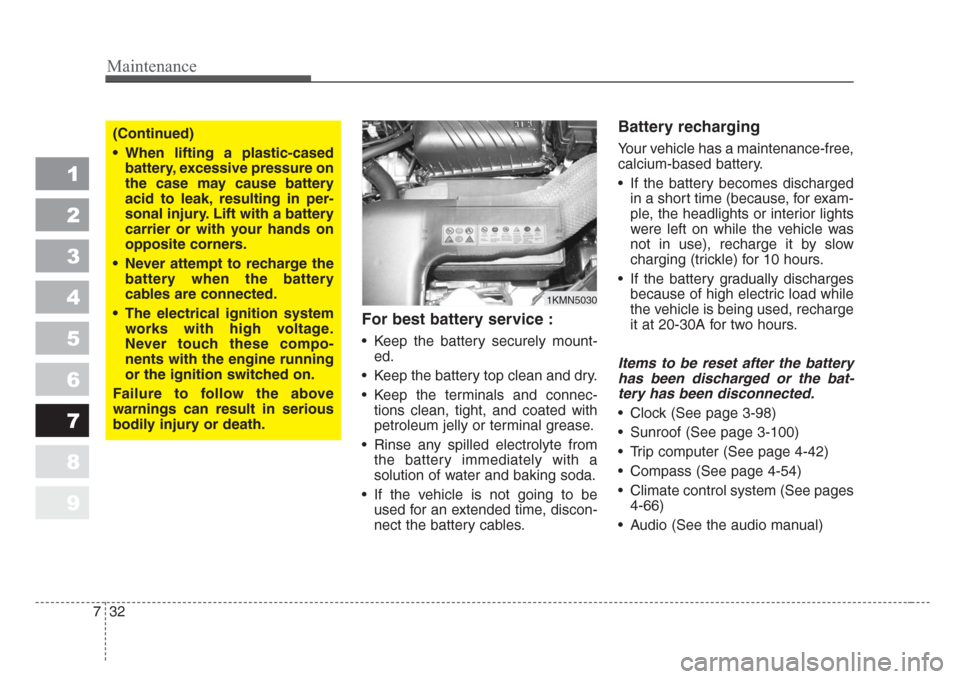
Maintenance
32 7
1
2
3
4
5
6
7
8
9
For best battery service :
• Keep the battery securely mount-
ed.
• Keep the battery top clean and dry.
• Keep the terminals and connec-
tions clean, tight, and coated with
petroleum jelly or terminal grease.
• Rinse any spilled electrolyte from
the battery immediately with a
solution of water and baking soda.
• If the vehicle is not going to be
used for an extended time, discon-
nect the battery cables.
Battery recharging
Your vehicle has a maintenance-free,
calcium-based battery.
• If the battery becomes discharged
in a short time (because, for exam-
ple, the headlights or interior lights
were left on while the vehicle was
not in use), recharge it by slow
charging (trickle) for 10 hours.
• If the battery gradually discharges
because of high electric load while
the vehicle is being used, recharge
it at 20-30A for two hours.
Items to be reset after the battery
has been discharged or the bat-
tery has been disconnected.
• Clock (See page 3-98)
• Sunroof (See page 3-100)
• Trip computer (See page 4-42)
• Compass (See page 4-54)
• Climate control system (See pages
4-66)
• Audio (See the audio manual)
1KMN5030
(Continued)
• When lifting a plastic-cased
battery, excessive pressure on
the case may cause battery
acid to leak, resulting in per-
sonal injury.Lift with a battery
carrier or with your hands on
opposite corners.
• Never attempt to recharge the
battery when the battery
cables are connected.
• The electrical ignition system
works with high voltage.
Never touch these compo-
nents with the engine running
or the ignition
switched on.
Failure to follow the above
warnings can result in serious
bodily injury or death.
Page 346 of 350
Specifications
6 8
1
2
3
4
5
6
7
8
9
Light Bulb Wattage
Headlights (Low/High) 55/60
Front turn signal lights 27
Position lights 5
Front fog lights (if equipped) 35
Stop and tail lights 28/8
Rear turn signal lights 27
Back-up lights 17
Rear side mark light 5
High mounted stop light LED
*1
License plate lights 5
Front map lamp 10
Center dome lamp 10
Rear dome lamp 10
Door courtesy lamps (if equipped) 5
Cargo area lamp (if equipped) 5
Glove box lamp (if equipped) 5
Light bulbs
*1LED : Light-emitting diode